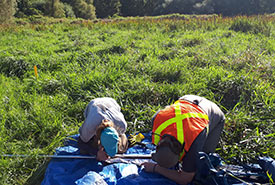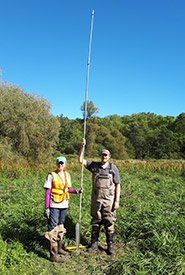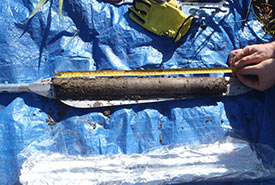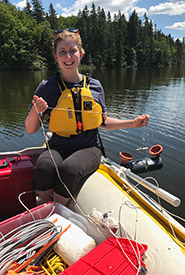Marshland in the Long Point Region has a long history — and holds a lot of carbon

A day in the field at the Long Point Biosphere Reserve (Photo by Amanda Loder)
There is growing discussion on the role of wetlands as natural climate solutions; meaning how we can conserve and restore these ecosystems to leverage carbon storage and greenhouse gas uptake from the atmosphere. This could ultimately help slow the pace of rapidly increasing global temperatures associated with the climate crisis.
Wetland plants remove carbon dioxide, a greenhouse gas, from the atmosphere. As the plants do not readily decompose, this enables leftover plant matter containing carbon to be buried and preserved in wetland soils. If the wetland is altered or drained, the stored carbon is at risk of degrading and being released as carbon dioxide back to the atmosphere. As a result, it is vital to keep these carbon stores in the ground and enable carbon sequestration (storage) while recognizing the other important functions and societal benefits (e.g., flood attenuation, cultural significance) that wetlands provide.
Bogs and fens are known for their carbon-rich soils, and for storing more carbon than they release, over long periods of time. Now, there is increasing recognition that mineral-based wetlands, such as freshwater marshes, can also contain significant carbon stores in their soils. Although mineral soils in freshwater marshes are not as highly concentrated in carbon as organic-based soils in peatlands, freshwater marshes cover large areas and can accumulate a lot of sediments and materials containing carbon over long periods of time. Collectively, this could add up to more carbon stored in the ground than previously appreciated.

The very long soil core sampler (Photo by Amanda Loder)
For my doctoral research, I examined undrained marshland situated on a property owned and managed by the Nature Conservancy of Canada (NCC) in the Long Point Biosphere Reserve — a UNESCO site located on the northeast shore of Lake Erie in southern Ontario. This freshwater marsh is adjacent to the Big Creek water channel in the Lake Erie watershed of the Long Point Biosphere Reserve where marshland was extensive prior to Euro-American settlement but has since been widely altered for farmland. My colleagues and I collected and conducted scientific analyses on soil cores from the undrained marshland, given its potential to contain undisturbed carbon stores. Our results show that this marshland is 6,000 years old and contains soils several metres in depth. The rate of sediment build-up in these marshes has varied relative to large fluctuations in Lake Erie water levels caused by glaciers retreating off the Ontario landscape, and to major landscape alterations associated with Euro-American settlement in the Long Point region. However, carbon burial has been high and sustained throughout the lifespan of this marsh.

A soil core sample (Photo by Amanda Loder)
The Long Point Biosphere Reserve is an example of how mineral-based freshwater wetlands can store a lot of soil carbon under the right kinds of conditions. My doctoral research also shows that significant stores of soil carbon are at risk of becoming degraded and released as greenhouse gases if freshwater marshes are drained or altered. On top of supporting biodiversity and filtering out excess nutrients headed into the Lake Erie water supply, marshes in this UNESCO watershed stabilize carbon, which could otherwise be in our atmosphere and contributing to further global warming. The next step for this work will be measuring the amount of greenhouse gases being released versus absorbed in real time, and the extent to which this marshland is having a net cooling effect on our climate over annual, decadal and centennial timescales
This research is published in Restoration Ecology and available through open access. It is co-authored by Sarah Finkelstein (University of Toronto), Sophia Zamaria (University of Toronto) and George Arhonditsis (University of Toronto Scarborough).
We thank Liv Monck-Whipp and Brett Norman at NCC for their great support and insight in making this research a success.
.


